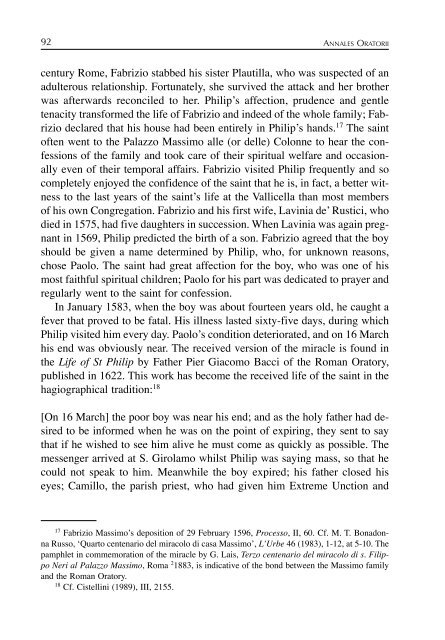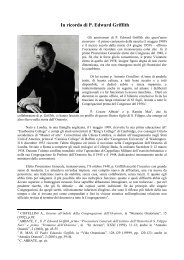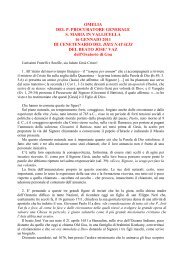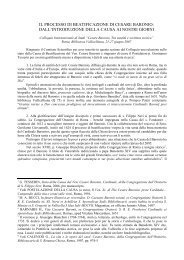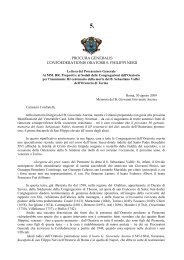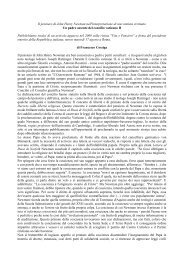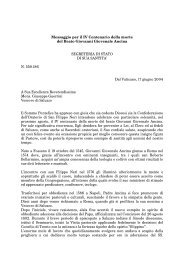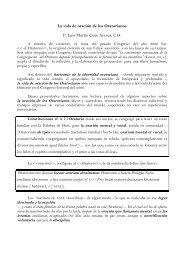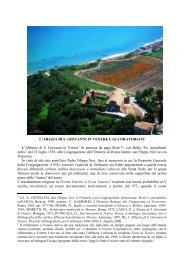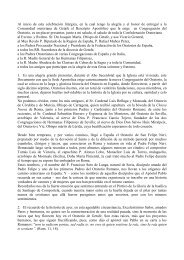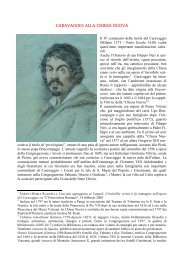- Page 3 and 4:
E. A. Cerrato, Al lettore3AL LETTOR
- Page 5 and 6:
E. A. Cerrato, Al lettore5ta le esp
- Page 7 and 8:
A Sua Santità Giovanni Paolo II7A
- Page 10 and 11:
S.S. Giovanni Paolo IIin visita a S
- Page 13 and 14:
E. A. Cerrato, Per il Sessantesimo
- Page 16 and 17:
12 ANNALES ORATORIIcorrispondenza c
- Page 18 and 19:
14 ANNALES ORATORIIFin dagli ultimi
- Page 20 and 21:
16 ANNALES ORATORIIl’impegno di p
- Page 22 and 23:
18 ANNALES ORATORIIIn quello stesso
- Page 24 and 25:
20 ANNALES ORATORIIostante le solle
- Page 26 and 27:
22 ANNALES ORATORIIsta assemblea. A
- Page 28 and 29:
24 ANNALES ORATORIIno quindici dell
- Page 30 and 31:
26 ANNALES ORATORIIIl nuovo Congres
- Page 33 and 34:
E. A. Cerrato, Per il Sessantesimo
- Page 35 and 36:
E. A. Cerrato, Per il Sessantesimo
- Page 37 and 38:
E. A. Cerrato, Per il Sessantesimo
- Page 39 and 40:
E. A. Cerrato, Per il Sessantesimo
- Page 41:
E. A. Cerrato, Per il Sessantesimo
- Page 44 and 45:
40 ANNALES ORATORIIse abre como un
- Page 46 and 47: 42 ANNALES ORATORIItimonio de aquel
- Page 48 and 49: 44 ANNALES ORATORIIpreponderantemen
- Page 50 and 51: 46 ANNALES ORATORIIvigilia - può b
- Page 52 and 53: 48 ANNALES ORATORIIE quanto egli ab
- Page 54 and 55: 50 ANNALES ORATORIIterna assistenza
- Page 56 and 57: 52 ANNALES ORATORIIne ben lungi da
- Page 58 and 59: 54 ANNALES ORATORII* * *Il migliore
- Page 61 and 62: A. Spina, P. Giuseppe Timpanaro57Ra
- Page 63 and 64: A. Spina, P. Giuseppe Timpanaro59Ma
- Page 65 and 66: A. Spina, P. Giuseppe Timpanaro61po
- Page 67 and 68: M. Delestre, L’influence de Saint
- Page 69 and 70: M. Delestre, L’influence de Saint
- Page 71 and 72: M. Delestre, L’influence de Saint
- Page 73 and 74: M. Delestre, L’influence de Saint
- Page 75 and 76: M. Delestre, L’influence de Saint
- Page 77 and 78: M. Delestre, L’influence de Saint
- Page 79 and 80: M. Delestre, L’influence de Saint
- Page 81 and 82: M. Delestre, L’influence de Saint
- Page 83 and 84: M. Delestre, L’influence de Saint
- Page 85 and 86: M. Delestre, L’influence de Saint
- Page 87 and 88: M. Delestre, L’influence de Saint
- Page 89 and 90: M. Delestre, L’influence de Saint
- Page 91 and 92: U.M. Lang, The miracle of St. Phili
- Page 93 and 94: U.M. Lang, The miracle of St. Phili
- Page 95: U.M. Lang, The miracle of St. Phili
- Page 99 and 100: U.M. Lang, The miracle of St. Phili
- Page 101 and 102: U.M. Lang, The miracle of St. Phili
- Page 103 and 104: U.M. Lang, The miracle of St. Phili
- Page 105 and 106: U.M. Lang, The miracle of St. Phili
- Page 107 and 108: U.M. Lang, The miracle of St. Phili
- Page 109 and 110: U.M. Lang, The miracle of St. Phili
- Page 111 and 112: U.M. Lang, The miracle of St. Phili
- Page 113 and 114: R. Sanz Hermida - M.T. Ferrer Balle
- Page 115 and 116: R. Sanz Hermida - M.T. Ferrer Balle
- Page 117 and 118: R. Sanz Hermida - M.T. Ferrer Balle
- Page 119 and 120: R. Sanz Hermida - M.T. Ferrer Balle
- Page 121 and 122: R. Sanz Hermida - M.T. Ferrer Balle
- Page 123 and 124: R. Sanz Hermida - M.T. Ferrer Balle
- Page 125 and 126: R. Sanz Hermida - M.T. Ferrer Balle
- Page 127 and 128: R. Sanz Hermida - M.T. Ferrer Balle
- Page 129 and 130: R. Sanz Hermida - M.T. Ferrer Balle
- Page 131 and 132: E. Crema, L’altra voce del Pelleg
- Page 133 and 134: E. Crema, L’altra voce del Pelleg
- Page 135 and 136: E. Crema, L’altra voce del Pelleg
- Page 137 and 138: E. Crema, L’altra voce del Pelleg
- Page 139 and 140: E. Crema, L’altra voce del Pelleg
- Page 141 and 142: E. Crema, L’altra voce del Pelleg
- Page 143 and 144: E. Crema, L’altra voce del Pelleg
- Page 145 and 146: E. Crema, L’altra voce del Pelleg
- Page 147 and 148:
E. Crema, L’altra voce del Pelleg
- Page 149 and 150:
E. Crema, L’altra voce del Pelleg
- Page 151 and 152:
E. Crema, L’altra voce del Pelleg
- Page 153 and 154:
E. Crema, L’altra voce del Pelleg
- Page 155 and 156:
E. Crema, L’altra voce del Pelleg
- Page 157 and 158:
E. Crema, L’altra voce del Pelleg
- Page 159 and 160:
E. Crema, L’altra voce del Pelleg
- Page 161 and 162:
G. Tesserin, Cardinali e Vescovi or
- Page 163 and 164:
G. Tesserin, Cardinali e Vescovi or
- Page 165 and 166:
G. Tesserin, Cardinali e Vescovi or
- Page 167 and 168:
G. Tesserin, Cardinali e Vescovi or
- Page 169 and 170:
G. Tesserin, Cardinali e Vescovi or
- Page 171 and 172:
G. Tesserin, Cardinali e Vescovi or
- Page 173 and 174:
G. Tesserin, Cardinali e Vescovi or
- Page 175 and 176:
G. Tesserin, Cardinali e Vescovi or
- Page 177 and 178:
G. Tesserin, Cardinali e Vescovi or
- Page 179 and 180:
G. Tesserin, Cardinali e Vescovi or
- Page 181 and 182:
G. Tesserin, Cardinali e Vescovi or
- Page 183 and 184:
G. Tesserin, Cardinali e Vescovi or
- Page 185 and 186:
G. Tesserin, Cardinali e Vescovi or
- Page 187 and 188:
G. Tesserin, Cardinali e Vescovi or
- Page 189 and 190:
G. Tesserin, Cardinali e Vescovi or
- Page 191 and 192:
G. Tesserin, Cardinali e Vescovi or
- Page 193 and 194:
G. Tesserin, Cardinali e Vescovi or
- Page 195 and 196:
G. Tesserin, Cardinali e Vescovi or
- Page 197 and 198:
G. Tesserin, Cardinali e Vescovi or
- Page 199 and 200:
G. Tesserin, Cardinali e Vescovi or
- Page 201 and 202:
G. Tesserin, Cardinali e Vescovi or
- Page 203:
G. Tesserin, Cardinali e Vescovi or
- Page 206 and 207:
202 ANNALES ORATORIIblos, alguno de
- Page 208 and 209:
204 ANNALES ORATORIIlina de Aragón
- Page 210 and 211:
206 ANNALES ORATORIIque cumplir anu
- Page 212 and 213:
208 ANNALES ORATORIIA este capítul
- Page 214 and 215:
210 ANNALES ORATORIImisión era, en
- Page 216 and 217:
212 ANNALES ORATORIILa unión del P
- Page 218 and 219:
214 ANNALES ORATORIIhispalense a en
- Page 220 and 221:
216 ANNALES ORATORIIlos filipenses
- Page 222 and 223:
218 ANNALES ORATORIItambién presen
- Page 224 and 225:
220 ANNALES ORATORIItólicos. Junto
- Page 226 and 227:
222 ANNALES ORATORIISeminario Mayor
- Page 229 and 230:
F. Colás Peiró, Antonio Gaudí, e
- Page 231 and 232:
F. Colás Peiró, Antonio Gaudí, e
- Page 233 and 234:
F. Colás Peiró, Antonio Gaudí, e
- Page 235 and 236:
A. Monzon i Arazo, El Beato Manuel
- Page 237 and 238:
A. Monzon i Arazo, El Beato Manuel
- Page 239:
A. Monzon i Arazo, El Beato Manuel
- Page 242 and 243:
238 ANNALES ORATORIIdi fede e di cu
- Page 244 and 245:
240 ANNALES ORATORIIria e prese spe
- Page 246 and 247:
242 ANNALES ORATORIIdre di Dio!. Es
- Page 248 and 249:
244 ANNALES ORATORIIcompensa. E qua
- Page 250 and 251:
246 ANNALES ORATORIIpromosse lavori
- Page 252 and 253:
248 ANNALES ORATORIIverno pontifici
- Page 255 and 256:
M. De Gioia, Il P. Edoardo Bouvier,
- Page 257 and 258:
M. De Gioia, Il P. Edoardo Bouvier,
- Page 259 and 260:
M. De Gioia, Il P. Edoardo Bouvier,
- Page 261 and 262:
M. De Gioia, Il P. Edoardo Bouvier,
- Page 263 and 264:
M. De Gioia, Il P. Edoardo Bouvier,
- Page 265 and 266:
M. De Gioia, Il P. Edoardo Bouvier,
- Page 267 and 268:
L. Avila Blancas, El venerable Padr
- Page 269 and 270:
L. Avila Blancas, El venerable Padr
- Page 271 and 272:
L. Avila Blancas, El venerable Padr
- Page 273 and 274:
L. Avila Blancas, El venerable Padr
- Page 275 and 276:
L. Avila Blancas, El venerable Padr
- Page 277:
L. Avila Blancas, El venerable Padr


